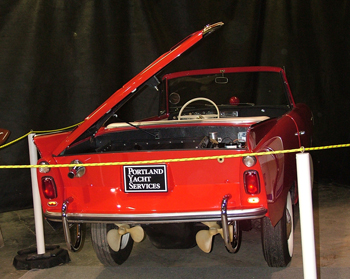The 770 Revolutionizes Drowning
The Amphicar is a German amphibious automobile, first mass-produced for sale to the public in 1961. The vehicle was designed by Hans Trippel and manufactured by the Quandt Group to be marketed and sold in the USA.
Compared to most boats or cars, its performance was modest, and only 4000 were produced by 1965. Nevertheless, it is still among the most successful amphibious civilian autos of all time, and still often prized and preserved as novelty collectible automobiles today.

A 1967 Amphibicar, owned by Tom Shaw of Gorham at the 2010 Maine Boatbuilders Show in Portland. Of the just under 4,000 total production, 3,046 went to the U.S. Fishermen's Voice Photo
Engine: Triumph four-cylinder engine of 1147 cc, 8.0 compression ratio, rated at 38.3 bhp
Chassis/body Overall length: 14.250 ft
Overall width: 5.083 ft
Height: 5 ft
Turning circle: 36.8 ft
Wheelbase: 7 ft
Front track: 4 ft
Rear track: 4.083 ft
Fuel tank capacity: 10.5 imperial gallons
Empty weight: 2,315 lb (includes fuel and oil)
Appearance Front undersurface is slightly pointed and sharply cut away below. The wheels are set low, so that the vehicle stands well above ground level when on dry land. Called the “Model 770”, the Amphicar could achieve speeds of 7 knots in the water and 70 mph (110 km/h) on land.
One owner said, “It’s not a good car and it’s not a good boat, but it does just fine” largely because of modest performance in and out of water. Another added, “We like to think of it as the fastest car on the water and fastest boat on the road.” In water as well as on land, the Amphicar steered with the front wheels, making it less maneuverable than a conventional boat. Time’s Dan Neil called it “a vehicle that promised to revolutionize drowning.”
Neil explained: “Its flotation was entirely dependent on whether the bilge pump could keep up with the leakage.” In reality, a well-maintained Amphicar does not leak at all and can be left in water, parked at a dock side, for many days.
Two Amphicars crossed the English Channel in 1968 enduring 20-foot waves and gale-force winds. Howard Singer of San Diego, California sailed an Amphicar from the mainland to Catalina Island in the late 1970s.
Production started in 1961. From 1963 to 1965 cars were assembled from parts inventory built up in anticipation of sales of 20,000 per year. Production ended in 1968.
